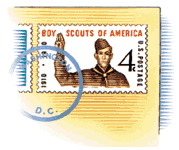![]() January-February 2001
January-February 2001

The October 2000 issue of Scouting magazine, with The Way It Was column about President Calvin Coolidge and his two sons who were Boy Scouts, has been placed in the permanent collection of the Calvin Coolidge Memorial Room at Forbes Library in Northampton, Mass., the largest Coolidge collection in the world.
However, the following correction was added to the article: Both Northampton (where the President's sons were born and were members of Troop 101 at Edwards Congregational Church) and Hatfield (site of the tobacco farm on which Calvin Coolidge Jr. worked) are in Massachusetts, not Vermont.
Visitors will note that a picture of Calvin Jr. working on the Hatfield farm and one of Mrs. Coolidge presenting an Eagle Scout badge to a member of Troop 101 are part of the center's current exhibit. (All of the several hundred photographs on display were selected from the thousands in the Forbes collection.)
A personal postscript: 65 years after joining the Boy Scouts, I am now serving as a member of the advisory board of the Pioneer Valley Council in western Massachusetts.
Richard C. Garvey
Northampton, Mass.
In an interview in the October issue, Chief Scout Executive Roy Williams spoke of a special moment in Scouting when his troop made rope using a cardboard box and coat hangers.
I think this would be an interesting task for my den. Can you share the process with us?
Lucy Cote
Henniker, N.H.
Simple techniques for making rope from string or twine are found in the Bear Cub Scout Book (BSA Supply No. 33107), under Achievement 22, "Tying It All Up," and in the Pioneering merit badge pamphlet (Supply No. 3382). The merit badge method, using wood frames and wire hooks, is probably similar to that described in the interview.
As the father of two sons with ADD and the assistant Scoutmaster of their troop (which also includes three other ADD boys), I salute Bill Sloan's article in the October issue.
... With a team effort between an understanding Scoutmaster (ours is the greatest!) and cooperative parents, Boy Scouting can be a great option for any boy with ADD. It develops self-discipline, goal-setting, learning to work with and for the common good of others, and achievement.
My oldest son is a Life Scout and assistant senior patrol leader; my youngest just became a Tenderfoot and takes pride in being a chaplain aide. I cannot describe the pride we all feel when they achieve a new rank or earn a merit badge.
Carl T. Wirth
Assistant Scoutmaster, Troop 553
Omaha, Neb.
Thank you for October's ADD article. I have worked with a number of ADHD (attention deficit/hyperactivity disorder) boys and adults in Scouting, and the challenges are real—but so are the rewards.
The advice in the "What Can Unit Leaders Do?" sidebar makes sense for all Scouts, but is especially true for creating a successful Scouting experience for an ADHD Scout. Boys with ADHD need structure and consistency; a positive Scouting experience in a well-run den and pack can make all the difference for these children as they move into the middle school years.
... When we meet the delightful challenges of some of these "higher maintenance" Scouts, we have a more interesting den or unit, and all those participating grow and learn from the experience. It helps to keep a good sense of humor and to remember that we as leaders are there to help each boy do his best. ...
Mary Redford
Den Leader and Committee Chairman, Pack 39
Stow, Mass.
A s a practicing pediatrician as well as a Scouter, I want to compliment you on the excellent and very practical articles you publish in Scouting magazine on child and adolescent behavior. "Unit Leaders and ADD" in the October issue and "How Children Can Overcome Shyness" in November-December were great.
Keep up the good work!
Elizabeth M. Stone, M.D.
Chartered Organization Representative
Ann Arbor, Mich.
Thank you so much for the October article on ADD. As the parent of a Webelos Scout who was diagnosed with ADHD at age 3, I was happy to see an article that would raise the awareness of not only unit leaders, but also Scouts and parents who read Scouting magazine.
Your sidebar tips and guidelines were especially helpful and appropriate. Parents and peers, as well as leaders, often misinterpret this "nonvisible" disability as intentional misbehavior on the part of the youngster. This misunderstanding can lead to great difficulty and demotivation for a Scout with ADHD. ...
... It is important that everyone involved in a troop or pack make a consistent effort to gain a positive understanding of Scouts who do not fit the "norm," because of ADD or any other reason. By doing so, we can have a tremendous impact on a boy's commitment to the lifelong values that Scouting provides.
Jill Havrilla Caban
Long Valley, N.J.
Copyright © 2001 by the Boy Scouts of America. All rights thereunder reserved; anything appearing in Scouting magazine or on its Web site may not be reprinted either wholly or in part without written permission. Because of freedom given authors, opinions may not reflect official concurrence.
| The Boy Scouts of America | http://www.scouting.org |